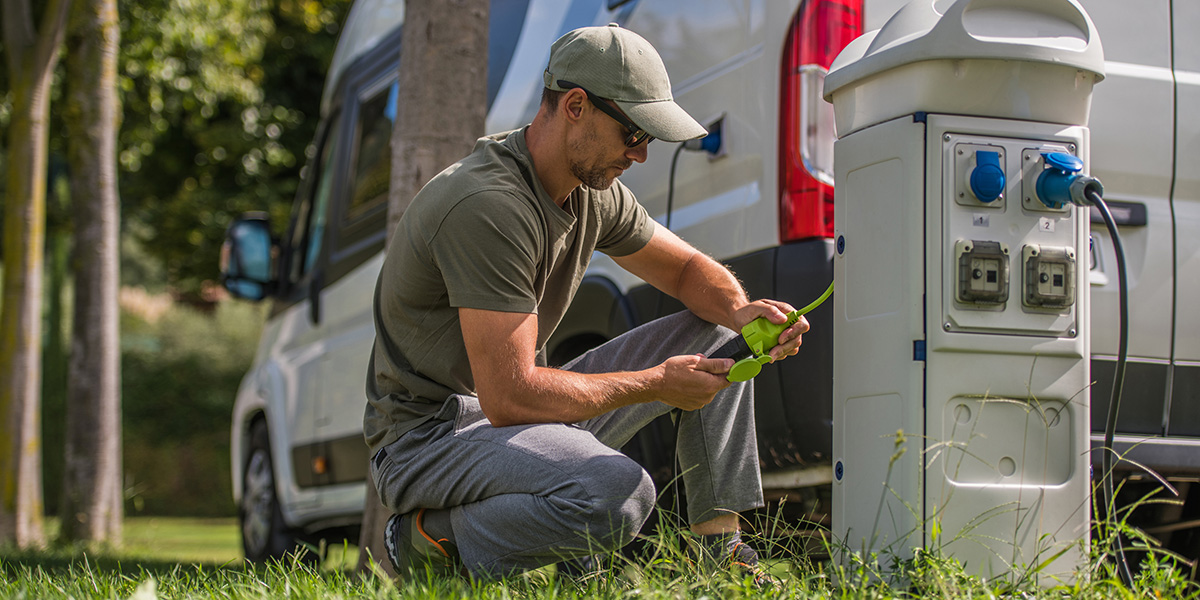September 9th is World Electric Vehicle (EV) Day, a day that celebrates sustainable mobility and changes coming to EV industries. Despite the special occasion, some campers are hesitant to consider electric RVs.
RV Trader recently held a survey on social media, asking our followers their number one concern with electric RVs. Participants answered that a lack of range and infrastructure to support these vehicles was their main point of skepticism. To help RVers fully understand electric RVs, we’re breaking down your primary concern while providing insights into what improvements are being made. And for more information about electric vehicles, visit our EV Resource Page.
When we asked “What do you think is the biggest issue with electric RVs?” we received thousands of responses, with most RVers sharing feedback like this:
“We don’t have the power grid to support them.”
“Initially range; then aged battery fatigue; battery replacement cost, and impossible battery recharge from an overburdened electrical grid.”
“Lack of adequate infrastructure.”
“You would need a charging station every 50–100 miles.”
“Range, battery degradation over time.”
“Trees don’t have outlets.”
Previously we’ve covered the benefits of electric RVs, including their innovative designs, low maintenance, and how they’re an eco-friendly alternative, among other advantages. However, the market is still in the early stages of developing electric RVs, noticeably lagging behind other EV industries, partly due to vehicle size and infrastructure needed. Yet public concern about the effect of greenhouse gasses from gas-powered vehicles is incentivizing manufacturers to develop more EVs to meet the interests of an expanding consumer base.
Electric RVs are starting to appear on the market, though many are still in their early phase of development. Bloomberg recently reported that Winnebago is developing an electric RV, or eRV that can reach a 125-mile range. Meanwhile, Thor has introduced eRV concepts using a lithium-ion battery pack, hydrogen fuel cell, and solar roof to reach 300 miles before needing a recharge. Green Car Reports shared that Thor’s electric RV meets an expectation that RVers have that they would like to be able to travel 5–6 hours from home before needing to recharge a battery.
Charging stations for electric RVs are becoming more evident at RV parks and fueling stations, but still aren’t widespread. On-board, portable hydrogen fuel-cell systems would mitigate the issue involving a lack of charging infrastructure for EVs, but distributing these fuel cells could be difficult. Aside from this, there remains a gap in the market for larger types of electric RVs, including motorhomes and fifth-wheels.
All of this said, the RV industry is starting to make headway when it comes to improving EV infrastructure, and even beyond the early electric RV concepts. Support is coming from manufacturers, dealers, RV organizations, the government, and RVers that are eager to purchase EVs as they become more accessible in the market.
The RV Industry Association and the Federal Highway Administration are showing their support for developing and building a national network of charging stations for electric RVs by utilizing grant and incentive programs provided by local and state governments. This is part of the effort to promote and ensure Americans have access to outdoor spaces while supporting new electric technology with RVs and other vehicles, and reducing harmful carbon emissions.
These infrastructure improvements, which would improve accessibility for electric RVs, would help increase the visitation to America’s campgrounds and parks, which already contribute $689 billion to the U.S. economy and support 4.3 million jobs. The state allocation of funds from these incentive programs would improve electric grid systems for RVs, supporting a broader infrastructure for you to enjoy the great outdoors and travel further. Recipients of these funds would include private campgrounds and dealerships.
When you combine this with an increase in demand from the public for EVs in the market, manufacturers have plenty of opportunity to capitalize and develop vehicles with greater charging ranges. This also implies that as the EV market expands, there will be a higher availability of charging stations and longer lasting batteries.
Right now, it’s understandable to have concerns about the current limitations with EVs in comparison to their fuel-powered counterparts. But as World EV Day approaches, it’s worth considering the improvements being made. When you look at the many advantages these vehicles present, and the direction the world of RVing is headed, the future looks bright for electric.
If you’re ready to purchase your next new or used RV, be sure to shop from all the nationwide listings on RVTrader.com.

Leave a Reply to Bill Gregor Cancel reply